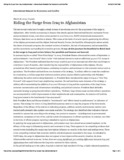Riding the Surge from Iraq to Afghanistan
| dc.contributor.author | Amara, Jomana | |
| dc.contributor.other | Defense Resources Management Institute (DRMI) | |
| dc.date.accessioned | 2014-04-14T17:52:38Z | |
| dc.date.available | 2014-04-14T17:52:38Z | |
| dc.date.issued | 2013-03-18 | |
| dc.identifier.uri | https://hdl.handle.net/10945/40422 | |
| dc.description | United States Institute for Peace, International Network for Economics and Conflict | en_US |
| dc.description.abstract | The last several weeks have brought a steady stream of unwelcome news for the proponents of the surge in Afghanistan. After initially announcing in January that attacks against International Security Assistance Forces and governments troops, were down seven percent in 2012 from 2011, NATO retracted and announced in February that there was no decline in attacks. This comes at the heels of several reports questioning the efficacy of the Afghan government and the Afghan National Security Forces, the feasibility of keeping the nation united, the claims of economic progress, the constant revision of statistics, the lack of transparency and accountability, and the uncertainty surrounding the transition process. It may at this juncture be beneficial to think back to the surge in Iraq and review history for parallels and lessons not learned. | en_US |
| dc.rights | This publication is a work of the U.S. Government as defined in Title 17, United States Code, Section 101. Copyright protection is not available for this work in the United States. | en_US |
| dc.subject.lcsh | Afghanistan | en_US |
| dc.subject.lcsh | Iraq | en_US |
| dc.subject.lcsh | Security Assistance | en_US |
| dc.subject.lcsh | Surge | en_US |
| dc.title | Riding the Surge from Iraq to Afghanistan | en_US |
| dc.type | Article | en_US |
| dc.contributor.department | Business & Public Policy (GSBPP) |


